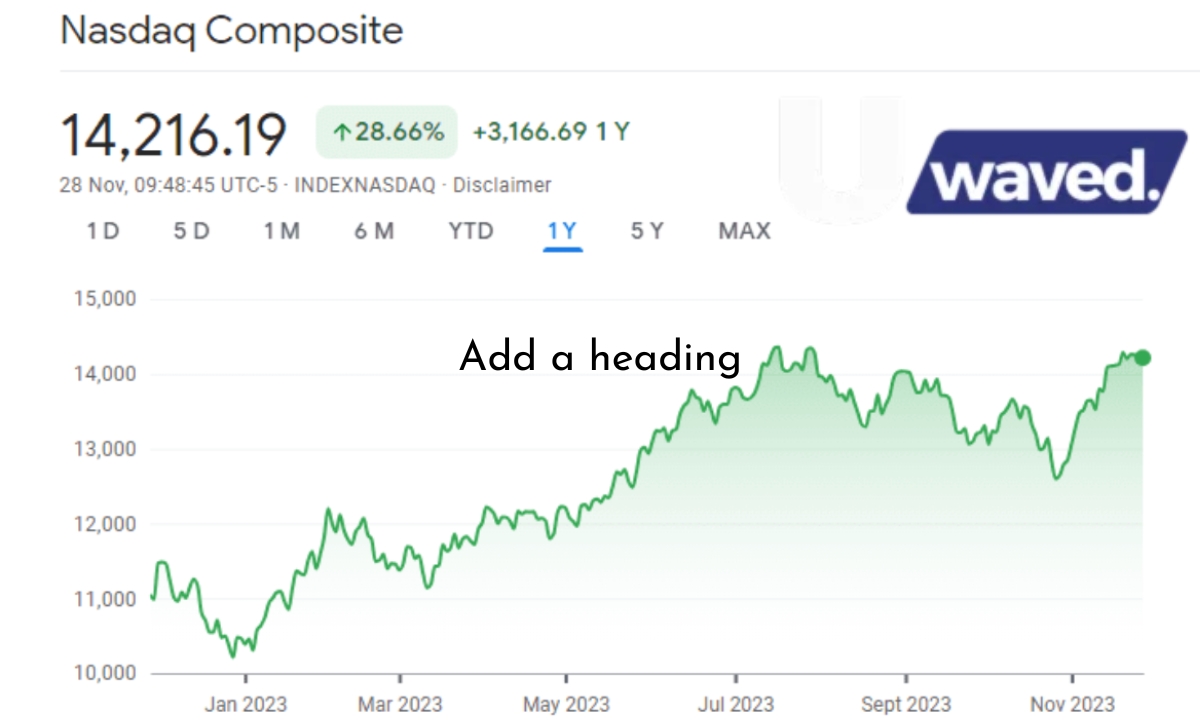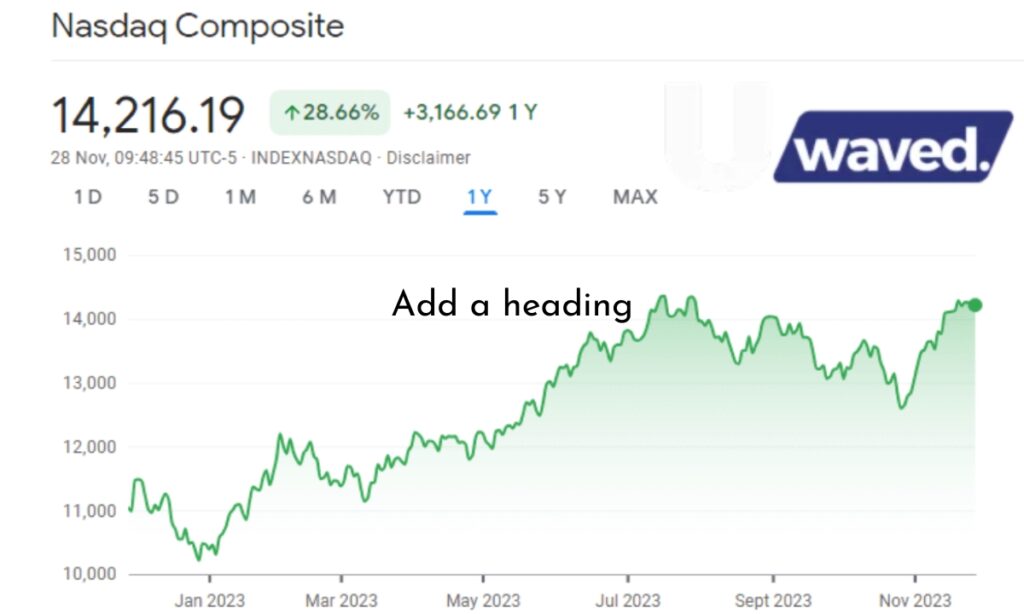Business
Indexnasdaq: .ixic: Latest Quotes, Charts, and Insights 2024

Indexnasdaq: .ixic
Greetings from the fascinating realm of the NASDAQ Composite Index (COMP), where financial expertise, creativity, and technology come together! You’ve come to the correct location whether you’re an astute investor or you’re just inquisitive about the stock market. We’ll go into great detail on the COMP in this blog article, covering everything from its intriguing past to its present performance and projections for the future. So fasten your seatbelts and get ready for an exciting journey through the stock and index universe! Prepare to learn the secrets of one of the most well-known indexes on Wall Street, indexnasdaq:.ixic 2024.
The NASDAQ’s past
Since its launch in 1971, the NASDAQ Composite Index, or COMP as it is more often known, has had a lengthy and intriguing history. It was developed as an electronic trading platform for companies not listed on conventional exchanges by the National Association of Securities Dealers (NASD).
At first, the majority of the firms in the indexnasdaq: .ixic were technology-related, reflecting the industry’s increasing prominence in the economy. It grew throughout time to incorporate businesses from a range of sectors, including consumer products, healthcare, and finance.
A noteworthy turning point in NASDAQ’s history occurred when it became a publicly listed corporation in 2002. With this change, investors may now directly buy NASDAQ shares and benefit from its growth.
Tech stocks reached previously unheard-of heights during the late 1990s dot-com boom, which is another noteworthy occurrence. The COMP increased dramatically during this time, but as the bubble burst, it witnessed a sharp collapse.
The NASDAQ Composite indexnasdaq: .ixic has continuously changed in response to shifting market patterns and advances in technology, despite these ups and downs. It is still one of the most watched stock market indices in the world today.
To sum up,
The NASDAQ has a history of innovation,
Knowledge of Index Performance and How It’s Determinedflexibility,
and tenacity.
It still has a significant impact on how investment plans are shaped and offers insightful information about market movements.
Going ahead into 2024,
It will be interesting to watch how this famous index develops in the future.
and react to fresh chances and challenges.
Watch this space for further developments!
The way the NASDAQ Composite (COMP) performs can have a big effect on how the market feels in general. However, how precisely is this performance determined? Now let’s explore the realm of index computations.
Tracking the prices of a certain set of stocks over time is how one determines the performance of an index. Regarding the COMP, it consists of all local and foreign businesses registered on the Nasdaq Stock Market. Because these equities are weighted according to their market size, the movement of the index is more heavily influenced by larger businesses.
The process itself is adding up the price of each stock and multiplying it by the weight assigned to it in relation to the total market value. This gives us a single figure that sums up the performance of these particular stocks.
It’s crucial to remember that although a lot of investors use indexes like COMP as performance benchmarks for their portfolios, they are not directly investable. Rather, people can invest indirectly through a variety of financial products including mutual funds and exchange-traded funds (ETFs).
Investors may make well-informed investment decisions and obtain insights into wider market trends by comprehending the formula used to compute index performance. An index’s ups and downs are a reflection of how investors feel about particular industries or sectors within it.
Knowing how an index such as COMP performs allows us to avoid depending just on individual stock research and provides us with important insights into market dynamics and ever-changing investing landscapes!
Amounts Influencing the COMP
Numerous variables impact the performance of the NASDAQ Composite Index (COMP). Market sentiment, which represents investors’ general opinion and confidence in the economy, is one important component. Good news and hopeful predictions frequently trigger more buying activity, which raises stock prices and helps the index.
The COMP is also influenced by business earnings. The performance of the index as a whole is impacted by the financial outcomes of NASDAQ-listed firms, which also have a significant impact on stock prices. Robust earnings releases have the potential to draw in additional investors, boosting stock values and fostering a favorable trend for the COMP.
The path of COMP is also significantly shaped by economic data. Interest rates, GDP growth, unemployment, inflation, and other factors all have an influence on investor mood, which in turn has an impact on market movements. For example, strong growth expectations or falling unemployment rates may boost investor confidence and raise stock values based on economic statistics.
The performance of the COMP may be impacted by government policies in both direct and indirect ways. Certain industries or sectors within the index may be directly impacted by changes in regulations or tax laws, which might have an influence on their individual stock values. Government initiatives to boost or stabilize the economy can also have an indirect impact on market patterns and investor mood.
Global occurrences such as natural catastrophes or geopolitical unrest may have a big influence on NASDAQ stocks and worldwide markets. The uncertainty surrounding these occurrences might cause global market volatility to increase as investors look for safer investment choices when things are turbulent.
The last but certainly not least are technical developments that influence the many industries included in the COMP index. Artificial intelligence (AI), blockchain technology, and renewable energy solutions are examples of innovations that have drastically changed how businesses operate on a global scale and affected their profitability. These innovations also change the dynamics of supply and demand, which in turn affects share price valuations and, ultimately, indices like the COMP.
To sum up,
Several variables impact the Nasdaq Composite Index (COMP), such as the state of the market,
government initiatives, economic indicators, and corporate earnings
developments in technology and world affairs. Gratitude
Leading Businesses in the COMP
More than 3,000 firms make up the NASDAQ Composite Index, or COMP as it is more often known. These businesses are involved in a number of industries, such as technology, healthcare, finance, and more. It should come as no surprise that the index includes several major businesses given the wide variety of sectors it represents.
Apple Inc. is a leading company in the COMP. (AAPL). Apple, which is well-known for creating cutting-edge devices like MacBooks and iPhones, has dominated the market and had a significant impact on the IT sector.
Microsoft Corporation is a notable enterprise within the COMP. (MSFT). Microsoft, one of the biggest computer companies in the world, creates software that is used by millions of people worldwide.
Among the index, Amazon.com Inc. (AMZN) is another notable business. The colossus of e-commerce has transformed the realm of online shopping and has ventured into several other industries, including cloud computing via Amazon Web Services.
Within the COMP, there are several more significant businesses in addition to these IT behemoths. Google’s parent firm, Alphabet Inc. (GOOGL), continues to rule internet search, while Facebook Inc. (FB) is still a major force in social media.
These leading businesses influence their particular industries, spur innovation, and improve market performance generally. Investors should pay close attention to these major actors while examining developments in the NASDAQ Composite Index.
It will be interesting to see how these leading businesses develop going ahead into 2024 and beyond, as well as any new competitors who could enter this dynamic index market.
Present Patterns and Perspectives on the COMP
With good cause, the NASDAQ Composite Index (COMP) has become a hot issue in the financial world lately. The index, which tracks over 3,000 technology businesses that are traded on the NASDAQ, has recently shown some intriguing patterns and revelations.
The COMP’s ongoing dominance by large tech businesses is one noteworthy trend. Large chunks of the index’s worth have always come from tech behemoths like Alphabet (Google’s parent company), Amazon, Facebook, Microsoft, Apple, and Alphabet. Over the years, the COMP has reached new heights thanks to their outstanding performance.
One other noteworthy observation is that the majority of the development in recent years has come from technology-focused businesses. Businesses in sectors including software development, e-commerce, cloud computing, artificial intelligence (AI), and semiconductors have benefited greatly from businesses that are becoming more digital and dependent on technology breakthroughs.
Moreover, it’s critical to remember that patterns within the COMP are significantly shaped by investor sentiment. Volatility in the market can have an effect on investor confidence, which in turn can have an influence on index stock prices. Market sentiment may be greatly impacted by a number of factors, including geopolitical events, shifts in government laws, and economic situations.
Furthermore, the COVID-19 pandemic affected a number of COMP-listed firms in both favorable and bad ways. During lockdowns, some digital companies benefited from the increased demand for online purchasing platforms and remote work solutions, while others suffered difficulties as a result of supply chain delays or a decline in consumer spending.
It’s hard to say with perfect clarity what the future holds for this dynamic indicator as we go into 2024 and beyond.
Any investment tied to the stock market carries some inherent uncertainty about its future success.
However, the growing amount of technology being incorporated into our everyday lives indicates that tech-focused industries will continue to be important sources of corporate development in the years to come.
In conclusion, existing patterns suggest that while technology-driven industries will prosper, large tech companies will continue to dominate the market.
Although the mood of investors and other variables might affect the index’s performance,

Forecasts for 2024 and Later
The performance of the NASDAQ Composite Index (COMP) in the upcoming years may be influenced by a number of significant variables. Even though it’s hard to know for sure what will happen, looking at existing trends might give some useful information.
The COMP’s technology businesses’ ongoing expansion is one thing to keep an eye on. Tech behemoths like Apple, Amazon, Microsoft, and Alphabet have been the main drivers of the index’s notable increases in recent years. Thanks to developments in artificial intelligence, cloud computing, and other cutting-edge technology, these businesses have a bright future ahead of them.
The state of the world economy should also be taken into account. International market swings do not exclude the COMP. Interest rates, inflation rates, and trade policies are a few examples of economic indicators that might affect investor mood and, in turn, the index’s performance.
The future of the COMP may also be influenced by changes in regulations. New restrictions may have an effect on the profitability and market value of large digital businesses as governments worldwide struggle with issues including privacy concerns and antitrust laws.
Additionally, how investors feel about risk might have an impact on the COMP’s future performance. Unexpected global crises or geopolitical developments might have an impact on market volatility.
In order to make educated selections about their portfolios of Nasdaq-listed equities, investors need remain up to date on these different criteria.
A thorough examination of several elements is necessary to fully comprehend where things may be going for this indexnasdaq:.ixic 2024 and beyond.
To sum up,
Although no one is in possession of a crystal ball that can accurately forecast the future performance of any financial instrument, we may get some insight into potential outcomes by considering past data, present trends, and basic economic indicators.
Consequently, it would be prudent for investors who are interested in this dynamic industry to monitor events pertaining to technological companies, the global economy, new laws, and market mood.
In this manner, they’ll be more capable of navigating the NASDAQ Composite Index’s constantly shifting terrain and

In summary
Thousands of stocks listed on the NASDAQ exchange are part of the frequently watched NASDAQ Composite Index (COMP). Its history of rapid expansion and instability is indicative of the dynamically shifting nature of the biotech and technology sectors.
Gaining an understanding of index performance calculation can help you make more informed decisions about market movements and investor sentiment. The movement of the COMP is influenced by a number of factors, including economic indices, investor psychology, business earnings releases, and geopolitical events.
Some of the most inventive and significant businesses in their respective fields are represented by the top COMP firms. These businesses, which range from e-commerce titans like Amazon and Netflix to tech behemoths like Apple and Microsoft, have created the modern world.
There are a number of noteworthy patterns that we are seeing right now in the COMP. A few of the sectors propelling growth within this index are the development of artificial intelligence (AI), digital payments, cloud computing services, and renewable energy technology.
As we look to 2024 and beyond, there are encouraging signs for more growth as well as certain hazards to be aware of. As with stock or index investment (such as the COMP), it is important to be informed about market movements while keeping an eye on the big picture.
Charts showing past performance patterns across different time periods may be useful analytical tools to remain up to date on current quotations from the NASDAQ Composite Index (COMP).
To sum up,
Investors may gain exposure to a wide range of innovative technology businesses that are continuously pushing boundaries and redefining sectors worldwide through the NASDAQ Composite Index (COMP). Although previous achievement can not ensure future outcomes,
Investors should continue to keep an eye on the major variables affecting index movements and diversify their portfolios according to their own risk tolerance levels.
Keep in mind that investing entails risk; as a result,
meticulous investigation
Careful thought should always be given before making any judgments on investments pertaining to indexes such as
the COMP or specific stocks that are part of them.
FAQs:
What is a part of the COMP (NASDAQ Composite Index)?
A stock market index that comprises all of the stocks listed on the NASDAQ exchange is called the NASDAQ Composite Index, or COMP. It encompasses a wide variety of businesses in several industries.
How is the COMP’s performance determined?
A weighted average technique is used to calculate the COMP’s performance. Since the market capitalization of each firm determines its weight in the index, larger companies have a higher influence on the index’s movement.
What variables can impact the COMP’s performance?
A number of variables can affect how well or poorly the COMP operates. These comprise economic metrics including unemployment, inflation, interest rates, and GDP growth. Furthermore, market sentiment and geopolitical developments may also influence index fluctuations.
What are some of the best businesses that are part of the COMP?
A:The technology-focused firms in this index have grown at an impressive rate in recent years. Technological developments in fields like social media platforms, cloud computing, and e-commerce services, among others, have contributed to this boom.
What projections can be made about the COMP for the years 2024 and beyond?
A: Given the speed at which technology is developing, the long-term outlook for technology-oriented sectors is bright, even if it is hard to forecast future market circumstances with absolute confidence.
Business
Digital PR and Link Building: What They Are, Differences, Characteristics, and Objectives

In the realm of online marketing, the terms “digital PR” and “link building” are commonly used, representing two important strategies in this field.
Digital PR is a marketing strategy aimed at enhancing the online visibility of a company or brand through managing relationships with digital media, bloggers, influencers, and other online figures. Link building is an SEO (Search Engine Optimization) strategy focused on acquiring high-quality links from other websites to one’s own site. These two strategies often overlap, as obtaining links from authoritative sources can also be an objective of digital PR. For both strategies, platforms like SeoLuxury.com can be used, offering an all-in-one tool to improve search engine rankings. Through the platform, you can find websites to propose your content to or use their expert copywriters for content creation if preferred.
What is Link Building and How to Do It
Link building is an SEO strategy that aims to obtain links from other websites to one’s own site to improve search engine rankings. Inbound links (backlinks) from authoritative and relevant websites can increase the authority of your site and help improve its visibility in search results (the SERP, Search Engine Results Page). The first phase of link building involves finding websites from which you can obtain backlinks. These sites should be relevant to your niche or industry and possess online authority. One of the best ways to obtain backlinks is to create high-quality content, such as informative and interesting guides, articles, infographics, or original studies for the target audience. Track obtained backlinks to ensure they are high quality. Additionally, diversify your link building strategy to maintain natural and credible backlinks in the eyes of search engines. Link building requires time, patience, and a strategic approach, but if done correctly, it can help improve your website’s visibility and search engine rankings in the long term.
Digital PR: What It Is, How It Works, Strategies, and Objectives
Digital PR, short for “Digital Public Relations“, is a marketing strategy that focuses on managing relationships and creating positive online visibility for a company, brand, or individual through the use of digital platforms and social media. The main objective of Digital PR is to build and maintain a strong online reputation and promote brand awareness. It involves managing relationships with digital media, online journalists, bloggers, influencers, and the online public. Digital PR experts aim to establish positive connections with these stakeholders to gain media visibility. Creating interesting, informative, or engaging content, such as press releases, articles, blog posts, videos, and infographics, is fundamental to Digital PR.
Digital PR specialists actively seek opportunities for online media coverage. They send press releases, articles, or contributions to online editors and journalists, hoping they will be published or mentioned in their articles. Digital PR requires constant monitoring of online reputation, meaning the image and perception of the company or brand on the web. Digital PR is essential for building and maintaining a positive online reputation, developing public trust, and improving online visibility.
Business
Exploring the Companies that satisfy sanpo yoshi : Companies Striving for Triple Goodness

Introduction:
In a world where profit often takes precedence, a concept like Sanpo Yoshi emerges as a refreshing paradigm shift. Rooted in Japanese philosophy, Sanpo Yoshi translates to “three-way satisfaction,” emphasizing the harmony and balance between the seller, the buyer, and society. It goes beyond the conventional understanding of business success, advocating for mutual benefit and sustainability. In this comprehensive article, we delve into the essence of Sanpo Yoshi, its principles, and the companies that exemplify its ethos.
Understanding Sanpo Yoshi:
Sanpo Yoshi embodies the holistic approach to business, aiming to benefit not just the company and its customers but also society at large. It encompasses three key stakeholders:
- The Seller:
- The company or the seller must benefit from the transaction, ensuring profitability and sustainability. However, this benefit should not come at the expense of others involved.
- The Buyer:
- Customers should receive value for their money, including quality products or services, fair pricing, and excellent customer service. Their satisfaction is integral to the concept of Sanpo Yoshi.
- Society:
- Beyond the immediate transaction, Sanpo Yoshi considers the broader impact on society. This includes environmental sustainability, social responsibility, and contributions to the community’s well-being.
Principles of companies that satisfy sanpo yoshi:
- Mutual Benefit: Sanpo Yoshi emphasizes win-win situations where all parties involved derive value and satisfaction from the transaction. This principle fosters long-term relationships built on trust and collaboration.
- Sustainable Practices: Companies practicing Sanpo Yoshi prioritize sustainable business practices, minimizing negative environmental impact and ensuring the well-being of future generations.
- Ethical Conduct: Integrity and ethical conduct are fundamental to Sanpo Yoshi. Companies uphold honesty, transparency, and fairness in all their dealings, earning the trust and respect of stakeholders.
- Social Responsibility: Beyond profit-making, Sanpo Yoshi encourages companies to contribute positively to society. This may involve philanthropy, community development initiatives, or ethical sourcing practices.
Companies Embracing Sanpo Yoshi:
- Patagonia:
- Known for its commitment to environmental sustainability, outdoor apparel company Patagonia epitomizes the principles of Sanpo Yoshi. From using recycled materials in its products to donating a portion of its profits to environmental causes, Patagonia prioritizes the well-being of the planet alongside profitability.
- Toms:
- Toms revolutionized the concept of corporate social responsibility with its “One for One” model, where for every pair of shoes sold, a pair is donated to a person in need. This commitment to social impact resonates with the spirit of Sanpo Yoshi, where business success is measured not just in financial terms but also in the positive change it brings to society.
- Interface:
- As a leader in sustainable flooring solutions, Interface exemplifies Sanpo Yoshi through its Mission Zero commitment to eliminate any negative impact the company may have on the environment by 2020. Through innovative product design, waste reduction initiatives, and carbon-neutral operations, Interface demonstrates that profitability and environmental stewardship can go hand in hand.
- Ben & Jerry’s:
- Beyond crafting delicious ice cream flavors, Ben & Jerry’s is renowned for its social activism and commitment to progressive values. From advocating for climate justice to championing fair trade practices, the company aligns its business objectives with broader societal goals, embodying the spirit of Sanpo Yoshi.
Challenges and Opportunities:
While the concept of Sanpo Yoshi offers a compelling framework for businesses to operate ethically and sustainably, it is not without its challenges. Companies may face resistance from shareholders focused solely on short-term profits, logistical hurdles in implementing sustainable practices, and skepticism from consumers wary of greenwashing.
However, the opportunities presented by embracing Sanpo Yoshi are equally significant. Companies that prioritize triple goodness stand to gain a competitive edge by differentiating themselves in the market, attracting socially conscious consumers, and fostering loyalty and trust among stakeholders. Moreover, by aligning business objectives with broader societal goals, companies can contribute to positive social change and leave a lasting legacy beyond financial success.
Conclusion:
In a world increasingly characterized by inequality, environmental degradation, and social unrest, the principles of Sanpo Yoshi offer a beacon of hope and a blueprint for a more equitable and sustainable future. By prioritizing mutual benefit, sustainability, and social responsibility, companies can not only thrive financially but also make a meaningful difference in the world. As consumers, investors, and citizens, we have the power to support and champion businesses that embody the ethos of Sanpo Yoshi, shaping a world where prosperity is shared, and all stakeholders benefit.
YOU MAY ALSO LIKE;How2Invest: A Beginner’s Guide to Financial Success
FAQs:
- What does Sanpo Yoshi mean?
- Sanpo Yoshi is a Japanese concept emphasizing triple goodness—benefit for the seller, the buyer, and society—balancing profit with social responsibility.
- How do companies practice Sanpo Yoshi?
- Companies practice Sanpo Yoshi by prioritizing mutual benefit, sustainability, and social responsibility in their operations and decision-making processes.
- Can Sanpo Yoshi be applied to all industries?
- Yes, Sanpo Yoshi principles can be applied to all industries, as they emphasize ethical conduct, sustainability, and societal contributions, regardless of the sector.
- What are the benefits of embracing Sanpo Yoshi for companies?
- Embracing Sanpo Yoshi can lead to a competitive edge, increased consumer trust and loyalty, and positive societal impact, fostering long-term success and sustainability.
- How can consumers support companies practicing Sanpo Yoshi?
- Consumers can support companies practicing Sanpo Yoshi by choosing their products or services, advocating for ethical business practices, and engaging in responsible consumption.
Business
Understanding the Role of Criminal Background Checks in Modern Employment Strategies

Key Takeaways
- Criminal background checks are central to maintaining a safe and trustworthy work environment.
- Adherence to legal guidelines such as the FCRA and EEOC is essential in background screening.
- Emerging trends in technology and globalization are shaping the future of criminal background checks.
What Are Criminal Background Checks?
A criminal background check is a cornerstone practice for employers aiming to establish a secure workplace and uphold high standards of safety and integrity. Such checks delve deep into a candidate’s past and highlight any criminal records that might raise red flags or pose a potential threat within a corporate context. The primary goal is not only to identify risks preemptively but also to foster a workplace wherein trust is built into the very fabric of the corporate culture. A thorough background assessment can include various levels of investigation, from local misdemeanors to more extensive federal criminal records, providing employers with a comprehensive view of an applicant’s history. The relevance of these background checks extends far beyond merely flagging past criminal behavior. In our information-driven age, a criminal background check may offer insights into one’s character by revealing patterns or behaviors that could potentially align or conflict with a company’s values and expectations. Employers conducting these screenings must walk a tightrope of due diligence, ensuring each check respects privacy rights while protecting the business’s and its stakeholders’ interests. In this balancing act, legal ordinances and guidelines play a pivotal role. Organizations must be fully versed in the stipulations of laws such as the Fair Credit Reporting Act (FCRA) and adhere to the best practices outlined by institutions such as the Equal Employment Opportunity Commission (EEOC). These checks guide employers in respectfully and responsibly exercising their right to vet potential employees, as supported by the legal considerations for employers laid out by government agencies.
The Benefits of Implementing Background Checks for Employers
Security and safety within the workplace stand as paramount concerns for employers. Conducting criminal background checks is a practical approach to addressing these concerns, offering valuable insights that could prevent future incidents that may compromise the well-being and security of personnel and clients. This precautionary practice acts as a filter to flag individuals who may have exhibited behaviors in the past that would deem them unfit for specific roles, especially those that require a high degree of trust and ethical conduct. The hiring process becomes more robust, thus forestalling events that could tarnish the organization’s reputation and disrupt the work environment. Furthermore, the strategic implementation of background checks signals current employees and the public that the organization is committed to operating with integrity and due diligence. This level of transparency and accountability can enhance the company’s profile in the eyes of consumers and prospective, high-quality employees. Additionally, a discreet and ethical approach to criminal background checks can lead to a more inclusive hiring process, as it prompts companies to consider the context and relevance of any findings rather than making swift, potentially discriminatory judgments. Such an approach underscores the value of second chances and can diversify and strengthen the talent within the organization.
Navigating Legal Compliance in Criminal Background Screening
The intersection of background screening with an individual’s privacy rights mandates a careful, meticulous approach guided by clear-cut legal standards. Among the primary regulatory bodies influencing this domain are the Fair Credit Reporting Act (FCRA) and the Equal Employment Opportunity Commission (EEOC). The FCRA imposes specific requirements upon employers, including obtaining the candidate’s consent before conducting a background check, ensuring the accuracy of the information obtained, and following set procedures if the information influences hiring decisions. Employers also must be vigilant about adhering to the EEOC’s guidelines, which aim to prevent discrimination in the workforce. Fulfilling these legal requirements demands rigorous adherence to procedures and access to up-to-date information regarding any changes in the law. Ignorance of the latest amendments or complacency in implementing established practices can render an organization vulnerable to legal repercussions, including costly lawsuits. A strategic approach often involves partnering with reputable external agencies that specialize in conducting background checks with an awareness of current legal peculiarities. By doing so, businesses protect themselves from potential litigation and demonstrate a commitment to ethical business practices.
Addressing Common Misconceptions About Criminal Background Checks
Myths surrounding criminal background checks can pose significant barriers to effective implementation and might deter well-qualified candidates from pursuing opportunities. Among the most prevalent misconceptions is the notion that any criminal history will automatically disqualify a candidate from consideration. Reality paints a more nuanced picture. Employers are increasingly encouraged to evaluate the circumstances and relevance of the record to the job in question. This allows for holistic decision-making that factors in rehabilitation, the nature of the offense, and the time elapsed since the incident. Additionally, privacy concerns are often voiced. A properly conducted background check should always be carried out with the full consent and awareness of the individual in question, thus safeguarding their privacy rights. Beyond this, employers are responsible for carefully handling sensitive information, ensuring it is used solely for hiring decisions. By adopting a transparent approach and respectfully addressing potential negative findings, employers can maintain a fair hiring process that respects the dignity of all applicants.
Integrating Background Checks with Broader Hiring Strategies
Criminal background checks should seamlessly integrate within a broader, strategic hiring framework for maximum efficacy. This means they are just one part of a suite of tools for evaluating candidates, including interviews, skill assessments, and reference checks. Employers can enhance their hiring methodologies by ensuring that background checks are not isolated assessments but complement a comprehensive evaluation process.
Communication about background check policies should be clear and consistent from the onset of the hiring process. Prospective candidates should be fully informed of what the checks entail and how the results could affect their employment opportunities. Transparent communication fosters trust and openness, contributing to a higher degree of engagement and confidence among job applicants. This transparency extends to technology executing background checks, allowing for a more streamlined and efficient process that candidates can easily navigate.
The Candidate Perspective: Preparing for a Criminal Background Check
From a candidate’s viewpoint, the prospect of undergoing a criminal background check can be intimidating, especially for those with records they fear may impede their job prospects. Understanding their rights under the FCRA and preparing for the process can alleviate some of this apprehension. The key is that candidates know they have the right to be informed about the background check, consent to it, and dispute any inaccuracies that arise. They should also be coached on articulating context around adverse findings, providing clarity, and mitigating concerns from potential employers. Equipping candidates to handle this step can result in a more open, positive recruitment process.
Ethical Considerations in Criminal Background Checks
While ensuring the safety and security of a workplace, employers must wrestle with the ethical dimensions of conducting background checks. Respecting applicants’ privacy and handling their personal information with integrity is paramount. Employers must balance the need for thorough vetting and honoring the respect and dignity owed to every candidate. A transparent and considerate approach, where candidates know what to expect and the information is used conscientiously and fairly, can help surmount these ethical challenges.
The Future of Criminal Background Checks
The realm of background checks is poised on the cusp of significant change, spurred by technological advancements like artificial intelligence (AI) and machine learning. These technologies introduce new levels of accuracy and efficiency into the screening process, reducing human error and potentially speeding up hiring timelines. As these tools evolve, continuous vigilance on their ethical implementation and regulation compliance will become crucial for employers. Updating policies to accommodate these innovations while maintaining a human-centered approach in the hiring process will be critical to their successful integration.
Conclusion: Building a Safer, More Trustworthy Workforce
In conclusion, the efficacy of criminal background checks arises from their ability to offer deeper insights into the potential risks associated with hiring individuals with specific backgrounds. When executed with legal diligence and ethical consideration, these checks are potent tools for building safer, more trustworthy teams. The landscape for background screening is ever-evolving, demanding adaptability and continuous learning from today’s employers. Organizations committed to these principles will find themselves well-equipped to enhance their hiring processes, secure their environments, and foster the growth of an integrity-driven workforce.
-

 Technology5 months ago
Technology5 months agoBoosting Customer Engagement Through App Loyalty Programs
-

 Technology7 months ago
Technology7 months agoGeekzilla Podcast: A Remarkable Journey into Geek Culture
-

 Blog6 months ago
Blog6 months agoMaterialistic Princess Spoilers Complete Story 2024
-

 Technology7 months ago
Technology7 months agoAiyifan: All You Need To Know About It
-

 Technology6 months ago
Technology6 months agoConcept of Coomersu: A Comprehensive Guide
-

 General4 months ago
General4 months agoExploring the Intricacies of Käämyäjä: A Step-by-Step Guide-2024
-

 General6 months ago
General6 months agoUnveiling the Marvels of Chagaras: Palm Grasshoppers
-

 Technology6 months ago
Technology6 months agoBertėjas: A Deep Dive into the World of Language Translation





















